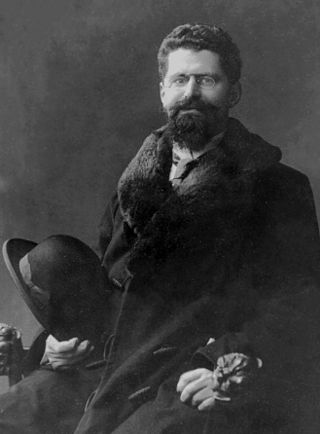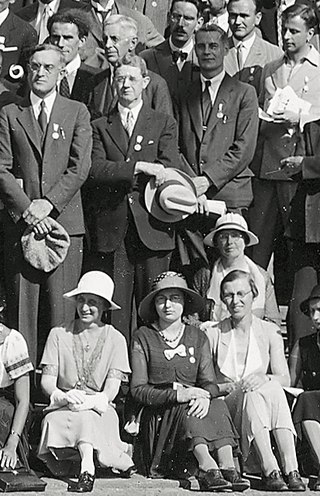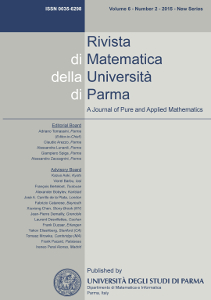In mathematics and especially differential geometry, a Kähler manifold is a manifold with three mutually compatible structures: a complex structure, a Riemannian structure, and a symplectic structure. The concept was first studied by Jan Arnoldus Schouten and David van Dantzig in 1930, and then introduced by Erich Kähler in 1933. The terminology has been fixed by André Weil. Kähler geometry refers to the study of Kähler manifolds, their geometry and topology, as well as the study of structures and constructions that can be performed on Kähler manifolds, such as the existence of special connections like Hermitian Yang–Mills connections, or special metrics such as Kähler–Einstein metrics.
In differential geometry, a G-structure on an n-manifold M, for a given structure group G, is a principal G-subbundle of the tangent frame bundle FM (or GL(M)) of M.

Francesco Severi was an Italian mathematician. He was the chair of the committee on Fields Medal on 1936, at the first delivery.
In mathematics, precisely in the theory of functions of several complex variables, a pluriharmonic function is a real valued function which is locally the real part of a holomorphic function of several complex variables. Sometimes such a function is referred to as n-harmonic function, where n ≥ 2 is the dimension of the complex domain where the function is defined. However, in modern expositions of the theory of functions of several complex variables it is preferred to give an equivalent formulation of the concept, by defining pluriharmonic function a complex valued function whose restriction to every complex line is a harmonic function with respect to the real and imaginary part of the complex line parameter.
In mathematics, and more specifically in differential geometry, a Hermitian manifold is the complex analogue of a Riemannian manifold. More precisely, a Hermitian manifold is a complex manifold with a smoothly varying Hermitian inner product on each (holomorphic) tangent space. One can also define a Hermitian manifold as a real manifold with a Riemannian metric that preserves a complex structure.

Laurence Chisholm Young was a British mathematician known for his contributions to measure theory, the calculus of variations, optimal control theory, and potential theory. He was the son of William Henry Young and Grace Chisholm Young, both prominent mathematicians. He moved to the US in 1949 but never sought American citizenship.
In mathematics, a Hermitian connection is a connection on a Hermitian vector bundle over a smooth manifold which is compatible with the Hermitian metric on , meaning that

Shoshichi Kobayashi was a Japanese mathematician. He was the eldest brother of electrical engineer and computer scientist Hisashi Kobayashi. His research interests were in Riemannian and complex manifolds, transformation groups of geometric structures, and Lie algebras.

Guido Zappa was an Italian mathematician and a noted group theorist: his other main research interests were geometry and also the history of mathematics. Zappa was particularly known for some examples of algebraic curves that strongly influenced the ideas of Francesco Severi.

Enzo Martinelli was an Italian mathematician, working in the theory of functions of several complex variables: he is best known for his work on the theory of integral representations for holomorphic functions of several variables, notably for discovering the Bochner–Martinelli formula in 1938, and for his work in the theory of multi-dimensional residues.
In mathematics and especially complex geometry, the Kobayashi metric is a pseudometric intrinsically associated to any complex manifold. It was introduced by Shoshichi Kobayashi in 1967. Kobayashi hyperbolic manifolds are an important class of complex manifolds, defined by the property that the Kobayashi pseudometric is a metric. Kobayashi hyperbolicity of a complex manifold X implies that every holomorphic map from the complex line C to X is constant.

Giovanni Battista Rizza, officially known as Giambattista Rizza, was an Italian mathematician, working in the fields of complex analysis of several variables and in differential geometry: he is known for his contribution to hypercomplex analysis, notably for extending Cauchy's integral theorem and Cauchy's integral formula to complex functions of a hypercomplex variable, the theory of pluriharmonic functions and for the introduction of the now called Rizza manifolds.

The Istituto Nazionale di Alta Matematica Francesco Severi, abbreviated as INdAM, is a government created non-profit research institution whose main purpose is to promote research in the field of mathematics and its applications and the diffusion of higher mathematical education in Italy.
Theodore Frankel was a mathematician who introduced the Andreotti–Frankel theorem and the Frankel conjecture.
In mathematics, Salomon Bochner proved in 1946 that any Killing vector field of a compact Riemannian manifold with negative Ricci curvature must be zero. Consequently the isometry group of the manifold must be finite.
Foundations of Differential Geometry is an influential 2-volume mathematics book on differential geometry written by Shoshichi Kobayashi and Katsumi Nomizu. The first volume was published in 1963 and the second in 1969, by Interscience Publishers. Both were published again in 1996 as Wiley Classics Library.
In mathematics, and in particular gauge theory and complex geometry, a Hermitian Yang–Mills connection is a Chern connection associated to an inner product on a holomorphic vector bundle over a Kähler manifold that satisfies an analogue of Einstein's equations: namely, the contraction of the curvature 2-form of the connection with the Kähler form is required to be a constant times the identity transformation. Hermitian Yang–Mills connections are special examples of Yang–Mills connections, and are often called instantons.
In differential geometry, algebraic geometry, and gauge theory, the Kobayashi–Hitchin correspondence relates stable vector bundles over a complex manifold to Einstein–Hermitian vector bundles. The correspondence is named after Shoshichi Kobayashi and Nigel Hitchin, who independently conjectured in the 1980s that the moduli spaces of stable vector bundles and Einstein–Hermitian vector bundles over a complex manifold were essentially the same.
Roberto Conti was an Italian mathematician, who contributed to the theory of ordinary differential equations and the development of the comparison method.

The Rivista di Matematica della Università di Parma is a peer-reviewed mathematics journal published by the Department of Mathematics and Computer Science of the University of Parma, established in 1950. It is devoted to publication of original research and survey papers in all areas of pure and applied mathematics: it also publishes workshops and conferences proceedings, following the tradition behind its foundation.








